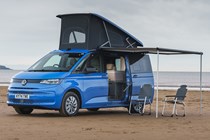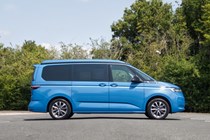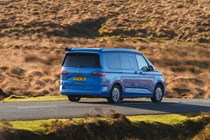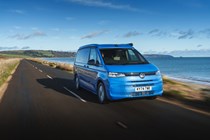
Volkswagen California interior, tech and comfort
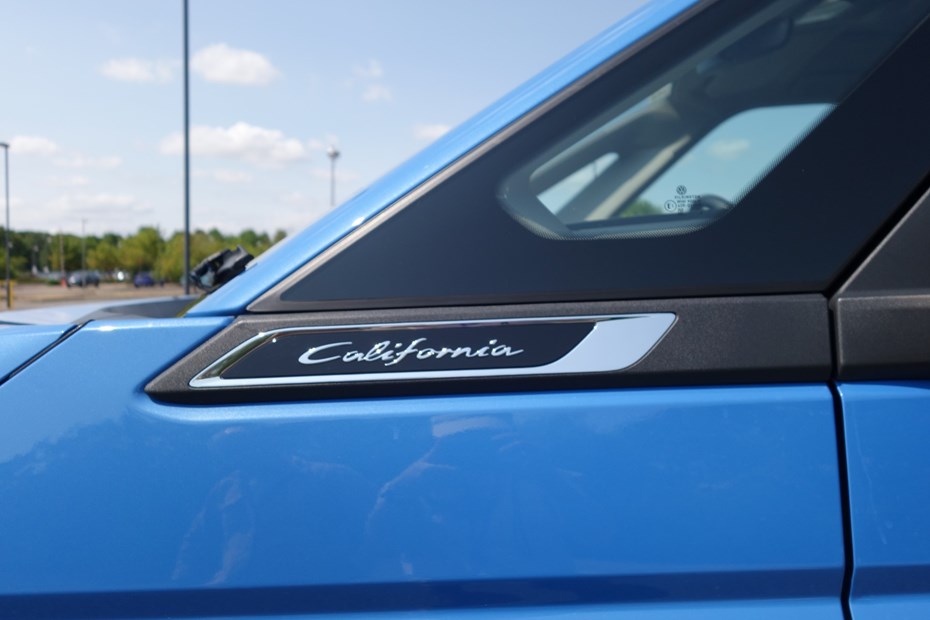
- Very well-made living space
- Good in-dash tech
- Packed with useful features
How is the quality and layout?
The Volkswagen California’s dashboard is largely very user-friendly. Starting in front of the driver, there’s an assortment of buttons for volume, phone and the adaptive cruise control on the steering wheel and a digital instrument panel. To the left, there’s the rocker switch gear selector. In the centre, there’s the 10.0-inch touchscreen infotainment system display and controls for the electrically operated roof and rear doors (when fitted).
Lower down, you’ll find the maddening touchpad controls for temperature and volume that have blighted so many recent VW’s – fortunately, you don’t have to use them. Below that, there’s a row of air vents then a drop-down section that reveals cupholders. To the right of that, you’ll find the parking brake and auto-hold switches. We covered the living space layout in the Practicality section of this review.
The whole interior feels quite plush – even the entry-level Beach model – and pretty much everything feels very robust – including the cupboards. There are inevitably some rattles from the living space, but nothing like the cacophony generated by some other campervans. The only area of concern we found in a test vehicle with 8,000 miles was a slightly loose ceiling panel.
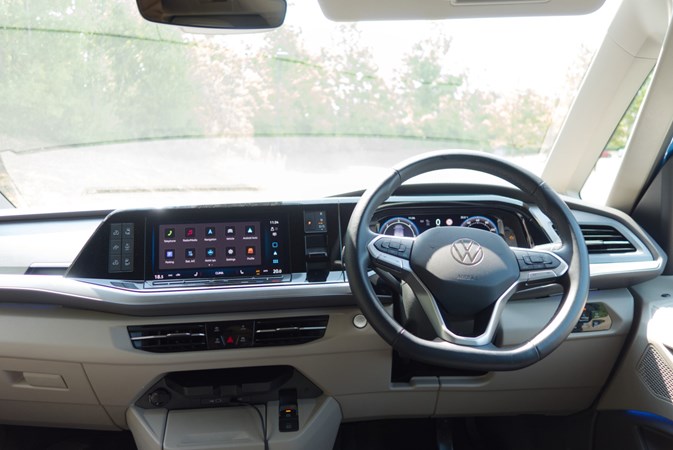
Infotainment and tech
All California models have a digital instrument display and a 10.0-inch touchscreen infotainment system with wireless Apple CarPlay and Android Auto connectivity. Both systems are a generation old and look a bit dated; they’re not as feature dense as some more recent systems, either. But the reliability issues that plagued this generation of VW infotainment seem to have been banished.
The menu navigation is easy to understand, and the screen responds snappily when pressed. Some of our testers experienced connection issues with Apple CarPlay, Android users didn’t have any. There’s no shortage of charging sockets, either, with USB-C, 12-volt and 240-volt three-pin sockets available.
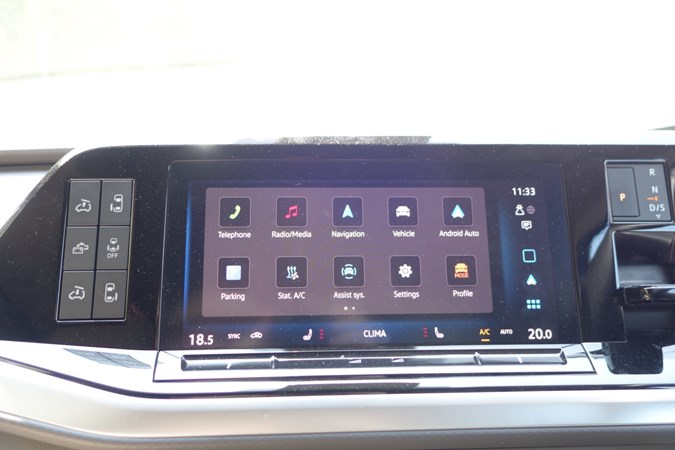
Comfort
All the California’s seats are extremely comfortable – relatively soft yet supportive in all the right places. The rear seats are slightly firmer than the fronts, but not to their detriment. Don’t underestimate the value of sliding rear doors, either. They make access so easy you can just walk in. There’s clear space between the front seats, as well, so you don’t need to get out and back in again.
Amusingly, there are no less than five ways of opening and closing the electric rear doors of Coast and Ocean models: the exterior handles, the interior handles, buttons on the B-pillars just in front of the doors, buttons on the dashboard, and buttons on the key fob.
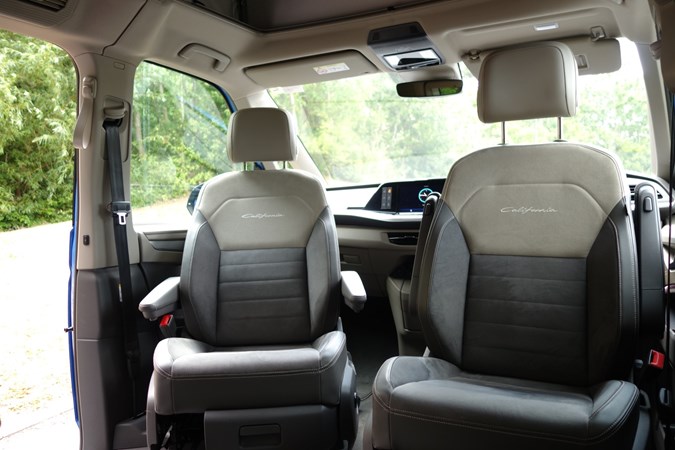
What features does the living space have?
All our experience of the California has been in top-spec Ocean models, so we’ll describe what that has and point out the differences in other models.
A 5.0-inch touchscreen on the right-hand C-pillar – just aft of the rear door – controls most aspects of the living space. It shows water tank levels and how much power is in the battery (plus an estimate of how long it’ll last). There isn’t a read-out for gas levels because there’s no way of getting a sensor in the bottle. The screen also controls the fridge, lighting and auxiliary heating, among other things. We found it really useful. The infotainment system has similar functionality – you can set the heating/aircon to come on at a particular time – as does the vehicle’s phone app.
The on-board leisure batteries can run the living space for at least 50 hours, even with a heavy draw. There’s an external 230-volt electrical hook up (a cable is provided) that constantly feeds power through the batteries. The internal 230-volt sockets – there are three – will run 240-volt domestic appliances such as a kettle or air fryer, but only with the external hook up in place.

There are fresh water and waste water tanks of 25 litres and 22 litres capacity respectively – quite large for this type of vehicle. Fresh water is filled via a cap found in the boot. A funnel is provided but we found an additional one was needed – or you can use a hose. Next to the cap, there’s the external shower outlet. The hose is found in the rear corner cupboard; it’s most effective for rinsing off. The kitchen sink is a bit too shallow for washing up. The tanks can be accessed for cleaning – rather awkwardly. The entry-level Beach model doesn’t have a water supply. On-board water is certainly convenient, but we found it was no less so to use tapped water carriers most of the time.
The gas bottle lives in a dedicated compartment and is easy to remove and connect. A tap in the kitchen unit turns on the supply to the single-burner hob. In Beach models, that’s found in a drawer that pulls out of the boot unit; in Coast and Ocean models, it’s under the kitchen unit’s lift-up glass top – alongside the sink. We cooked all our meals in the vehicle and found an auxiliary hob was necessary. Notably, the Citroen Holidays has a twin-burner hob.
The kitchen unit extends into the left rear door opening but leaves enough space to climb in past it. The drawer fridge is in the unit’s base, opening towards the front of the vehicle. We were surprised how much we could pack in, and it kept everything nice and cool even in 30-degree-plus heat.
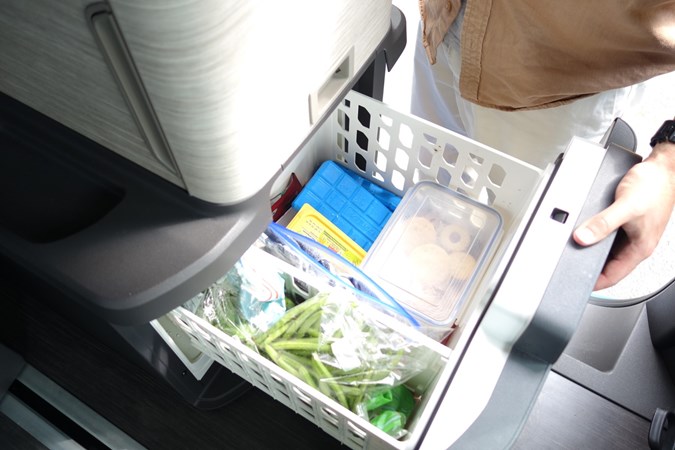
With the left rear door open, you can access the fold-out table. We used it externally, taking advantage of the three-pin socket found in the same recess to boil the kettle. It can also be detached and mounted above the fridge.
While we’re outside, let’s cover the Thule awning available on all models and fitted to our test vehicle. You wind it out with a crank kept behind a flap in the unit’s front end; legs extend out of the awning, and you can attach guy ropes if needed. We were surprised how easy it is to do and how stable it is without guys.
There’s also a folding table and chairs. The table is kept under the lower bed platform, the chairs in a zip-up compartment on the tailgate. They all feel really sturdy; the chairs have a higher back than those in the T6 California, improving comfort.
Lights are even fitted inside the cupboards. The front seats swivel to face the rear but doing so isn’t as easy as you’d hope. Slide them all the way forwards, move the steering wheel all the way in and up, open the doors (you need the clearance), then pull a strap to turn them round.
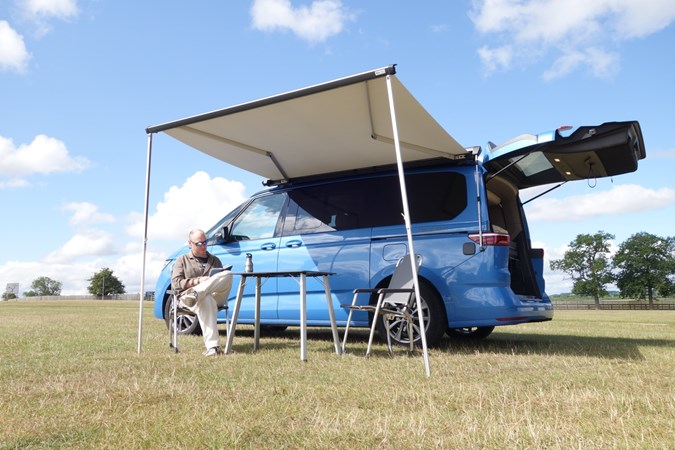
What’s sleeping in the Volkswagen California like?
Really rather comfortable. There are lower and upper beds, both of which support 200kg. The California is sold as a four-berth camper – two in each bed. That’s a realistic prospect in the upper bed, and the lower bed in Beach models – assuming everyone gets on well and doesn’t sleep in the foetal position. The lower bed in Coast and Ocean models is only a metre wide thanks to the built-in cupboards, so it’s really a single.
The upper bed in the pop-top roof is easiest to set up. The roof is manually operated in Beach models, electrically in Coast and Ocean. We’ve only experienced the electric roof and it’s rather aggravating. It’s operated via dashboard buttons that can be slow to respond, and the vehicle sometimes questions the wisdom of doing so. It’s a particular problem when closing the roof which we found has to be gradually lowered to make sure the canvas sides fold in properly.
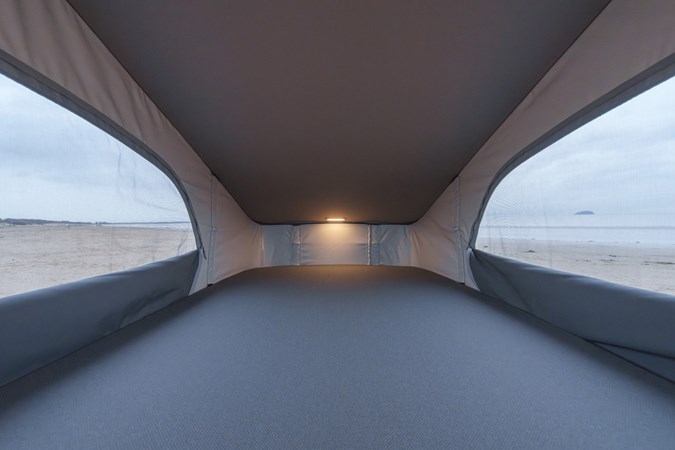
Once the roof’s up, slide back the access panel above the front seats; another panel over the rear quarters lifts up for internal standing room. There are mesh vents with zip-up covers in the canvas front and sides for ventilation and light; the front vent unzips to create a clear opening. Being up there on a balmy summer evening is just delightful. Less so in winter, because there’s no insulation.
Getting up there is a palaver, as VW doesn’t provide a ladder. We found the only way of doing it is to boost off the front seats while heaving yourself up bum first, bracing across the opening. You need to be reasonably strong and limber to do it. Once up there, it’s actually really comfy if you don’t mind the firmness of the pocket spring mattress. There are power sockets and a light at the opening, plus two more lights at the rear – we found extra illumination was needed to read in the dark.
The lower bed is easier to get into but more of a hassle to build. First, slide the back seats forwards, then fold them back by pulling the centre strap. Next, pull the right-hand strap and push the seat back down to lock it into the sleeping position (the left-hand strap folds the seat back forwards). Now, slide the seats up to the bed platform and hoist the mattress onto them. The mattress folds in three segments; one has a hard base that goes over the seats. Again, it’s firm but perfectly comfortable, even if there is a slight step in the base.
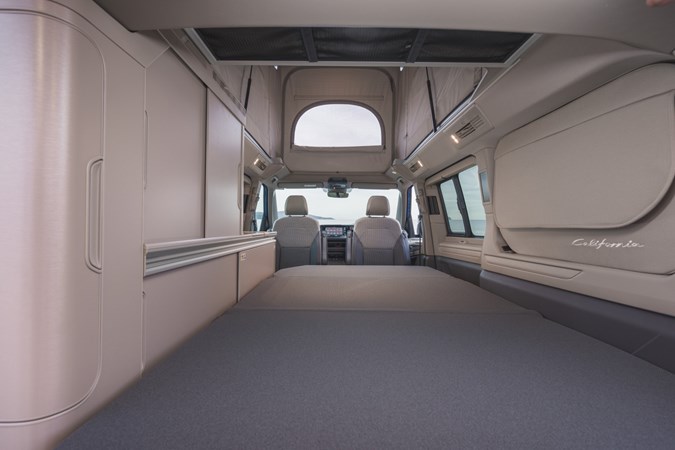
Roller blinds cover the tailgate and rear door windows. Plastic vents slot into the front door window openings. Quilted covers attach over the front door windows magnetically, another goes inside the windscreen once you’ve inserted a five-piece frame. One of our testers and his partner spent one of the hottest weekends of 2025 in the California. They slept in different beds – neither was big enough for both of them. With the top vents partly uncovered, the front door window vents in place and the rear door windows half-open, there was sufficient airflow without the aircon running. The roller blinds were used, but the quilted covers were deemed unnecessary – they are in winter for the extra insulation and very cosy it would be with the auxiliary heater going. Our tester’s partner noted she had the best night’s sleep in longer than she could remember.


